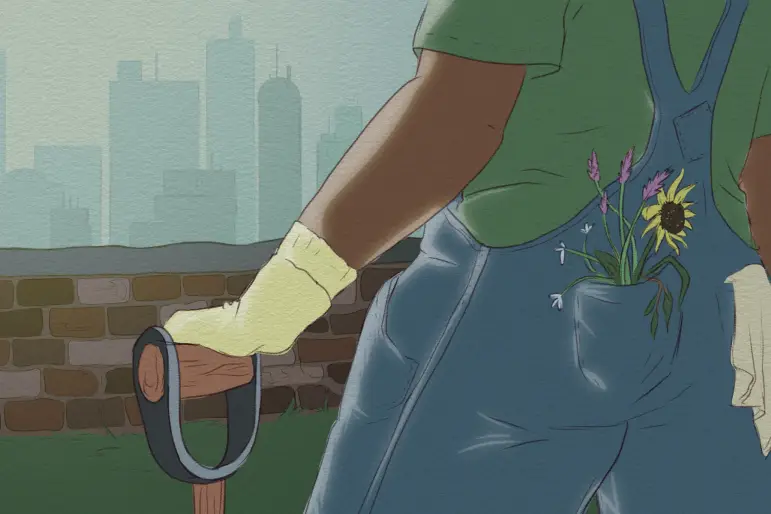People have always been curious about the future. Speculative and dystopian fiction are mainstays of popular culture for good reason and laid much of the groundwork for modern art movements. For instance, during the ‘70s and ‘80s, we saw the early beginnings of cyberpunk, which still has a death grip on the science fiction genre. After becoming massively popular, similar genres popped up, combining dreary, high-tech aesthetics with different historical stages.
Then, in 2008, a colorful new edition known as solarpunk joined the list of cyberpunk derivatives, and years later, it became more fashionable through social media as a popular aesthetic. Though nominally similar to other subcultures, solarpunk sets itself apart in multiple ways.
What Is Solarpunk?
Unlike its bleak peers, solarpunk embraces bright colors and natural settings, combining science fiction with idealistic politics. This contrast is evident in its very name, which attaches solar and other renewable energy sources to the punk subculture.
Obviously, solarpunk is an environmentalist twist on speculative fiction and punk politics, in which the future is filled with renewable energy and advanced technology that doesn’t seek to dominate nature, but work with it as a means to improve people’s standard of living and undo the damage of decades past.
And as the other half of its name suggests, solarpunk advocates for a move away from corporate dominance and toward collectivism, building on some of the anti-authoritarian ideals of punk subcultures to advocate for a more inclusive and less hierarchical society. It rejects capitalist and colonialist narratives that view the environment as something to own or subdue, and instead seeks to advocate for political and ethical causes through aesthetic and imagination.
Thus, solarpunk art (of which there are plenty of non-homogenous examples) makes use of urban settings flush with greenery, with trees growing out of apartment complexes and lush gardens marking every street corner. Ecological architecture and down-to-earth lifestyles are often the central focus, with additional influences from indigenous and non-Western cultures.
But solarpunk art also highlights inclusive and leftist ideologies. Solarpunk narratives can be vivid fantasies or slice-of-life stories, but regardless of the genre, these works often explore similar themes of decentralization, human collaboration and social justice.
Putting Solarpunk In Context
The solarpunk movement is unique in the way it embraces both scientific development and environmentalism. It also bears strong similarities with previous trends that underlined the importance and beauty of the natural world.
In the 1800s, pastoralism and romanticism rose as distinct responses to rationalism and the Industrial Revolution, leaning toward the simplicity of rural life and beauty of human existence. Pastoralism idealized the sweet countryside, untouched by the steady march of urbanization, with paintings and novels depicting a humble existence among rolling fields as something inherently desirable. Similarly, romanticism emphasized the subjectivity of human experiences with its wild emotion and individual creativity, often combined with a general appreciation of nature.
The spiritual successors to these ideas, such as cottagecore, goblincore and solarpunk, similarly fulfill a longing for a simpler, less commodified way of life in reaction to late-stage capitalism and modern stressors — although solarpunk is certainly the most political out of the bunch.
It makes sense that past artistic movements are mirrored in the modern day. Besides the obvious fact that nature has always been a subject of art, the situations that made way for pastoralism and romanticism during the industrial period are not too dissimilar from our modern climate crisis. Many people feel distanced from nature, and to cope, they romanticize what once was through creative expression.
But unlike the days of the Industrial Revolution, it’s harder to avoid politics. Every time we’re online, we’re likely to come across some pastel infographic or news excerpt describing the dangerous trajectory our planet is on. For example, I recently woke up and was greeted by a post that read “UN CLIMATE REPORT WARNS OF CODE RED FOR HUMANITY.” I kept reading, for some reason, and needless to say, I didn’t exactly start my day in a good mood.
Doomscrolling in general is too easy in this day and age. I find myself down an addictive rabbit hole of depressing statistics and predictions, and social media doesn’t exactly discourage me — or anybody else, for that matter — from doing so. People also suffer from a steadily growing disconnect from nature and frustration with ineffective institutions.
All of these factors contribute to climate anxiety, or the effects of climate change on mental health. Last year, the American Psychiatric Association (APA) conducted a poll that found out that around 55% of Americans are “somewhat or extremely anxious about the impact of climate change on their own mental health.”
Though more common among Gen Z and younger people in general, climate anxiety affects all groups, as the effects of global warming have shaped the way people imagine their futures. The APA has multiple articles on the subject, noting that “climate change and related disasters cause anxiety-related responses as well as chronic and severe mental health.” Though climate change anxiety is a highly debated topic, especially in the ways it affects people of color differently than it does white people, it is no less real, and it has manifested in some truly worrying ways.
With eco-fascist arguments decrying overpopulation and widespread poverty as the source of our environmental problems, some people have taken to violent measures. Others simply find themselves burnt out or suffering from activism fatigue. Even when people go largely unaffected by climate anxiety, there is a lingering sense of dread as we step closer and closer to irreversible environmental degradation, and ineffective coping with climate anxiety can cause more social harm than anything else.
Our Modern Environmental Aesthetics
As popular aesthetics and artistic movements often reflect modern anxieties, solarpunk reflects on our ongoing worries about the future. But solarpunk and other similar aesthetics online shift the attention away from worst-case scenarios, offering ways we can act as stewards of the environment.
Cottagecore, a relatively popular online aesthetic, provides an idyllic lifestyle distinct from the hustle and bustle of city life. Centered mostly around rural life, as the name suggests, this trend romanticizes a harmonious (and fashionable) coexistence with nature. Goblincore and its sister aesthetics do the same, though with a more untamed version of the natural world, as it readily accepts the creepy, weird and ugly in ways that cottagecore does not. Despite these surface-level differences, however, both of these trends indicate a general dissatisfaction with the demands of modern society in various ways.
And solarpunk, the most active of them all, encapsulates this dissatisfaction perfectly. Scrolling through the tag on Tumblr, Twitter and Instagram, I can readily find beautiful art and vibrant fashion sandwiched between gardening tips, petitions, sustainable DIYs and so, so many people talking politics. Yet instead of delving into the evils of humanity, people allow careful optimism to seep into every critique and analysis of our current systems.
Solarpunk is a movement that does not ask people to escape the problems of real life, but to solve them, and it doesn’t engage in bleak predictions to do so. Instead, it promises us a better future should we rise to the challenge, accepting people as necessary protectors and participants in the environment.
This movement is also politically uplifting in its acceptance of humanity — as it skirts around the depressing and terrifying possibilities for the planet’s future, solarpunk emphasizes our right to exist on this Earth, which is radically optimistic in so many ways, especially when eco-authoritarian rhetoric, environmental racism and systemic poverty all but ensure that marginalized people are the most likely to experience the effects of climate change. Shifting blame from the average person to corrupt systems also refocuses the conversation not around how we can adapt to capitalism but how we can move away from it and what that might look like.
Therefore, solarpunk is inherently political and ethical. It exists for systemic change and grassroots organization, and the incorporation of politics into aesthetics balances social awareness with some much-needed emotional escapism.
Being prone to bouts of activism fatigue and downer musings myself, this new way of looking at life is strangely liberating. It gives me a way to sidestep any negative spiraling without also ignoring social issues, and gives me a goal to work toward.
How We Go On From Here
This movement is still quite small, but in a way, it’s necessary. Plus, the ethos of solarpunk has influenced actual change. Though far from congruent with the profit-based motivations of most tech companies, solarpunk has encouraged firms like Carbon Up Technology, which works with artists to create products made of carbon-captured material. Additionally, people who appreciate the aesthetic have also created online communities to promote self-sustainability on local scales. And the anti-capitalist, egalitarian activism that this subculture encourages is just as important in our ongoing fight to save the planet.
Of course, we’re not exactly on track to fixing the world’s problems. Recent reports have made it clear that we’ll need far more extreme plans to actually combat global warming, and some of the changes that have already taken place, like melting polar ice caps and rising sea levels, will be irreversible for centuries to come. But there are “seeds of something better” here.
After all, I can only get through so much doomscrolling before I feel like I need a break from climate change activism in its entirety. But the uplifting visuals and narratives surrounding solarpunk recontextualize our right to exist. It may be easy to dismiss solarpunk as a niche corner of the art world, but this radical vision might be what we need to keep us going.

















